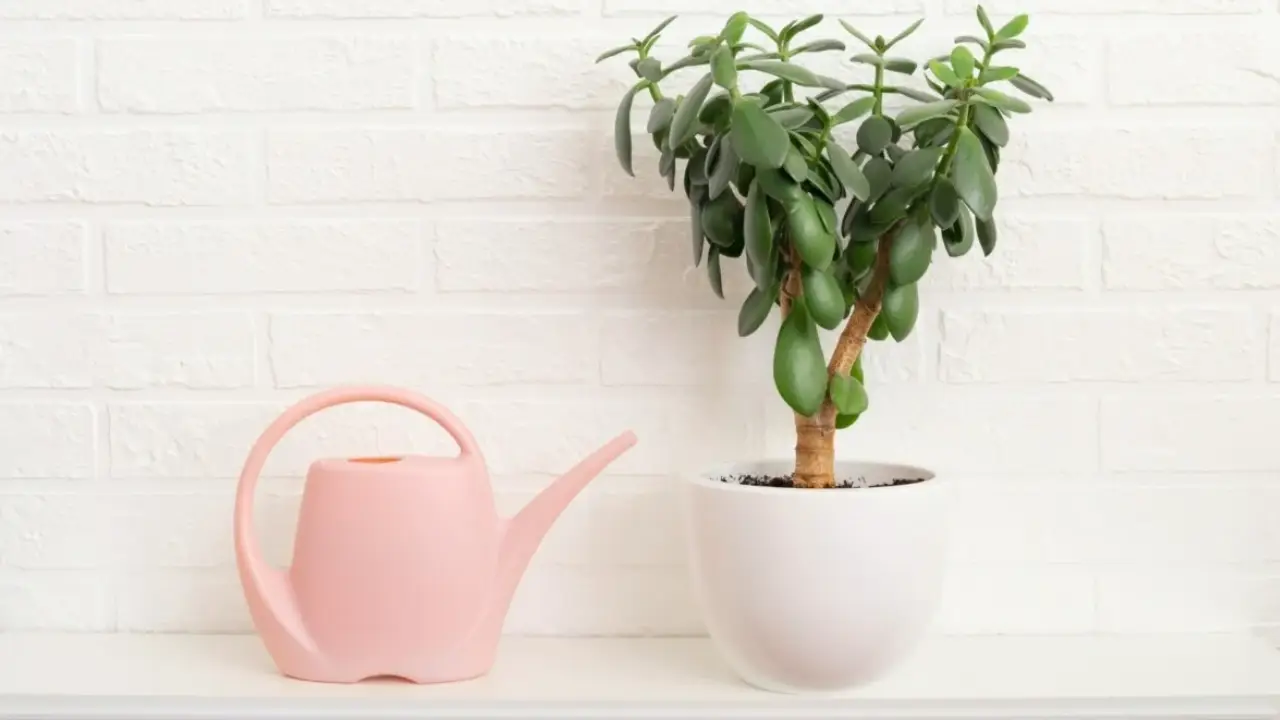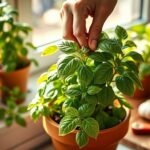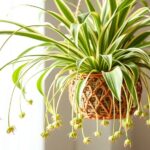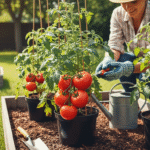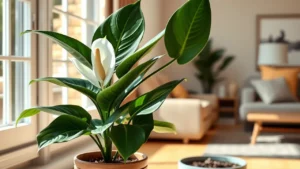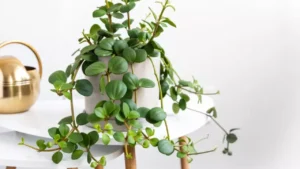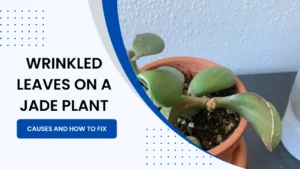Easy-care, low maintenance, and miniature – what else one could want?
It’s no wonder that jade plants are so popular because they only need a minimum amount of watering and the perfect amount of sunlight. However, determining how often to water jade plants is a concern that many gardeners have.
What does it mean to be ‘minimal watering?’ How often should you water a jade plant? What does your jade plant want? Is it drowning or begging for water?
If your mind is racing with all these questions, then this is the right article for you! In this article, I will explain in detail how often your jade plant needs to be watered.
In addition, I have compiled other essential aspects of watering a jade plant. If you follow the right instructions and methods, you can pass down your jade plant for generations to come.
Table of Contents
How Often to Water Jade Plants
The jade plant is a succulent that grows well in hot and dry climates where rainfall is infrequent. Also, its thick leaves and stems help them store moisture. Furthermore, by opening the stomata at night rather than during hot and sunny days, the Jade leaves to prevent water loss (transpiration).
Due to Jade plants’ tolerance for drought, they prefer dry conditions and are therefore susceptible to root rot and yellowing leaves caused by overwatering.
To grow jade plants successfully in your home or garden, you must mimic their native watering conditions.
Water your jade plant only when the soil around the roots is completely dry between waterings. Typically, jade plants should be watered every 14 days.
In most cases, the soil does not dry out at the same rate due to several factors:
- Climate and humidity levels.
- Pot size (smaller pots dry out much faster).
- Indoors or outdoors, your jade plant should be positioned in a region with significant airflow.
- Moisture retention capacity of the soil.
To find out how frequently you should water your jade plant, feel the soil in the pot through the drainage hole. If the soil feels moist, you should wait to water it, but if it feels dry, water it now.
When you follow the watering schedule for your potted jade, you can reproduce the cycle of drought followed by rain that it is accustomed to in its natural habitat.
How to tell if you are watering your jade plant too often or not often enough…
No matter how hot and arid your climate may be, if you water your jade plants more than once per week, you are probably watering them too frequently.
When a jade plant is overwatered, its leaves turn yellow, translucent, and eventually black, which is a sign of rot.
For jade plants whose leaves are turning yellow or translucent, cut back immediately on watering and let the soil completely dry out.
However, it is very important to take action if your jade leaves are turning black or showing black spots, as this is an indication of rot.
The first sign that jade is suffering from drought stress is a shriveling of the leaves, wilting, and perhaps even browning of the leaves as a result of underwatering.
When this occurs, the solution is to soak the soil well, wait for it to dry out again, and then soak it again.
In 2 watering cycles, the jade should show signs of recovery, and the leaves should look plump instead of shriveled.
Additionally, jade may require more or less watering depending on the time of year.
How Often to Water Jade Plants in Winter
Even indoors, jade plants require different amounts of moisture depending on the season.
During the Winter, jade plants require less watering since evaporation from the soil is slower. Because the temperatures are cooler.
For this reason, you should check the moisture of your soil through the drainage hole. Also, adjust your watering frequency so that the soil around the roots dries completely between waterings.
It is also important to consider whether your indoor jade plant is close to a source of heat, such as a radiator. These can cause daily temperatures to fluctuate and cause the soil to dry out more rapidly.
However, the jade plant will remain healthy as long as the soil has a chance to dry out between waterings.
In Winter, water your jade plant once every 3 weeks, but always check your soil to determine how often to water your jade plant.
How Often to Water Jade Plants in Summer
Growing jade plants in the Spring and Fall can help them live for 100 years, whereas if the temperature stays high throughout the Summer, growth slows significantly.
During hot weather, jade plants may go dormant and cease to grow. In countries such as South Africa and Mozambique where summer temperatures can be extreme, jade plants use this survival strategy to conserve water.
In the summer, the jade plants lessen their demand for moisture because of high temperatures, so watering should be scaled back.
During dormancy, jade plants should be watered less often as excess moisture around the roots can cause root rot.
For Jade trees, water them once every 3 to 4 weeks if the temperature is higher than 80°F (26°C). However, if the leaves shrivel then water them more frequently.
For your particular climate, finding the optimal balance of watering can take some experimentation.
How Much to Water Jade Plants
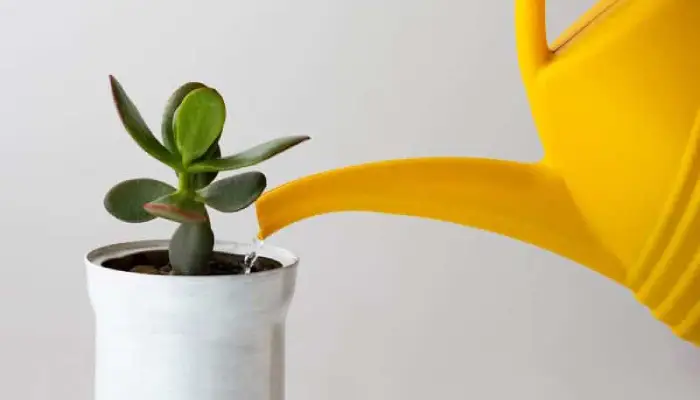
If you want your succulent to thrive, you have to know how much water it needs!
While the amount of water your jade plant needs can vary depending on climate, humidity, and temperature, the frequency of watering should not.
Give your jade plants a good soak so that the water runs out of the bottom. In this way, the soil is infiltrated so that the roots can absorb the moisture they need.
Furthermore, generous watering leads to the roots growing deep into the soil and maturing, strengthening the plants’ resistance to drought.
When water is applied too lightly, the top inch of soil is moist but it does not reach the roots, resulting in the jade plant leaves turning shriveled and eventually brown.
Jade plants naturally grow in an environment with sudden, infrequent deluges of rain followed by droughts and hot temperatures. Soaking the soil and letting it dry out replicates these conditions.
Well Draining Soil to Avoid OverWatering
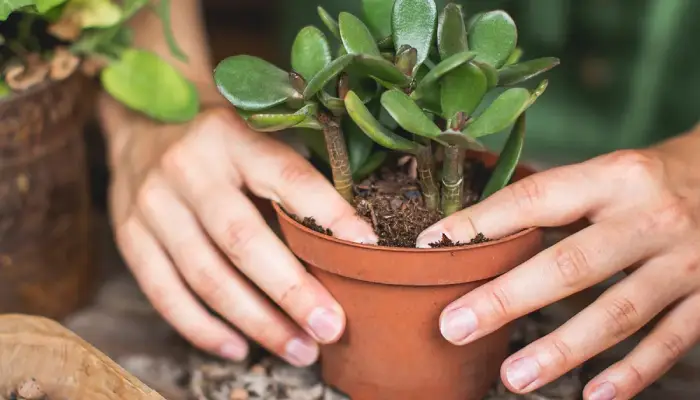
To avoid root rot, it is important to water jade in the appropriate well-draining soil mix.
In ordinary potting soil, water is retained too much around the roots and the leaves become yellow or translucent.
Moreover, peat-based potting mixes tend to repel water when they dry out. Thus it prevents moisture from reaching the roots of your jade plant and causes drought stress.
In their native South Africa, jade plants naturally grow in sandy, gritty soil. Usually on hillside slopes that drain quickly and don’t retain moisture very well.
Garden centers and Amazon offer specially formulated succulent and cactus potting mixes. This potting mix mimics a succulent’s native soil characteristics and soil profile to keep jades healthy and prevent root rot.
By using the right soil, you can maintain the perfect moisture balance for your jade plant and prevent any effects of overwatering.
Water Jade Plants in Pots with Drainage Holes in the Base
Plants like jade do not tolerate damp soil, so the base of your pot should have a drainage hole so that excess water can drain.
Also, water the pot so that the water trickles out the bottom. This is a great way to determine whether the soil at the bottom of the pot is moist or dry. Additionally, you know when to water your jade plant.
When you plant jade in pots without drainage, water pools around the roots and causes root rot, resulting in yellow, translucent, and eventually black leaves.
In your pot, water can still pool around the roots if:
- If the roots or compacted soil is obstructing the drainage hole. At that time, it is worth checking whether you should clear the hole in the base. Check this when you notice that your soil drains slowly.
- Put saucers and trays underneath your pots. To prevent water from spilling in your home, saucers or trays are often used underneath plant pots. To prevent water collecting and keeping the soil too damp for your jade plant, empty the saucer or tray regularly.
- A decorative outer pot. Most jade plants come in plastic pots with drainage holes, but you can use a decorative outer pot that looks good and prevents water from spilling. As a result, the outer pot prevents water from escaping and keeps the soil damp, causing root rot, so either empty the pot regularly or plant in a pot with drainage holes.
What Happens If You Underwater Jade Plants?
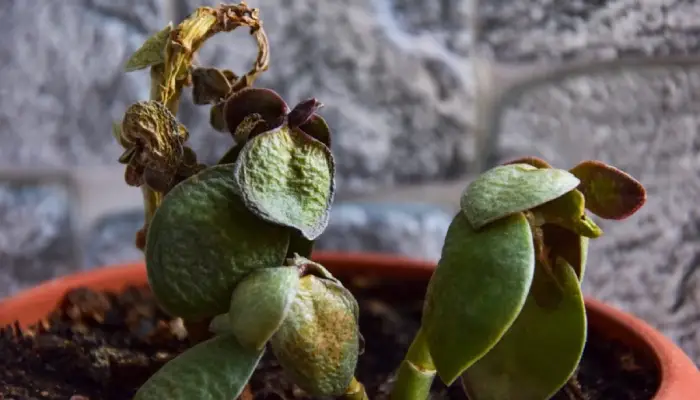
Your jade should be a little thirsty. However, never let the potting mix of your jade dry out completely.
When plants are underwatered or dried out, their leaves become limp, wrinkled, and start to fall off. Any remaining leaves may develop brown spots.
The roots begin to dry out. However, there is a chance that the plant can recover, but it will take time.
So, is there anything you can do?
Yes, allow the potting mixture to collect some moisture by watering the plant a little. When the potting medium is soaked or flooded, it leads to problems such as edema.
What Happens If Jade Plants Are Overwatered?
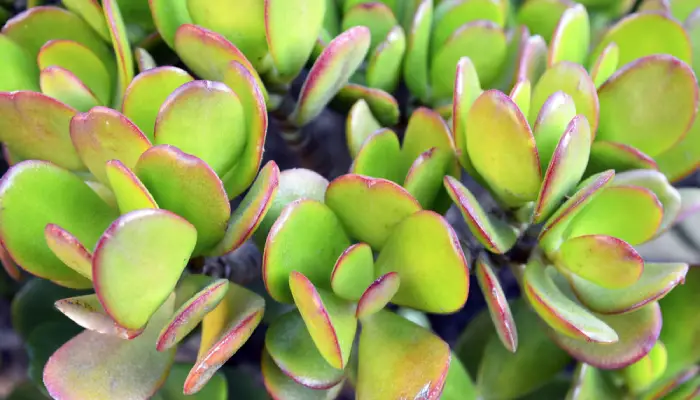
Overwatering can cause jade branches to become rubbery and start to fall over. As a result, the leaves become waterlogged and squishy. Also, there is a possibility that the roots will rot.
Additionally, if your plants have been standing in water for an extended period, consider repotting them.
Whenever you repot, use fresh potting mix. Wait about a week before watering your plant after repotting. After that, water thoroughly. Lastly, before watering again, let the soil completely dry out.
Moreover, avoid fertilizing for at least four weeks after repotting. After that, take a few healthy leaves or stem cuttings to propagate the Jade plant if its roots are rotting. By doing this, you will be able to replace your mature plant if the original plant does not survive.
What Can I Use To Water My Jade Plant?
You can use a small watering can with a long spout. Self-watering globes and spikes are also useful tools for watering jade plants.
It is especially helpful to have these as they can help you maintain a regular watering schedule and prevent overwatering.
In addition, self-watering planters can be used. They drain well and automatically water your plants. Thus, you will never have to worry about when or how much to water again.
All the time, the plant will effectively retrieve the right amount of water.
When Do You Water A Jade Plant?
Normally, a jade plant in a clay pot requires watering every 10 to 14 days. In plastic pots, jade plants usually require watering twice a week to three times a week.
It is a succulent plant, so its leaves hold water. Hence, it is not good for them to sit in wet or moist soil.
Also, when watering, make sure the water is thoroughly drained. Before watering again, let the mix dry almost completely.
Keep an eye on your Jade plants! Indoors, you should water Jade twice a month or once a month.
What Should You Do With Jade Plants When You Go On Vacation?
Happy vacation!
Water your Jade plant thoroughly before heading out. When you return, your Jade should be fine.
It’s one reason people love Jade succulents. They are always there to welcome you home!
Conclusion
Both beginners and experienced gardeners can take care of a jade plant.
Just remember to water jade plants regularly when the soil is dry, or every seven to fourteen days.
Also, to maintain your jade plant’s health and vitality, water it more regularly during the spring and summer growing seasons.
In the comments section, feel free to ask any questions.

